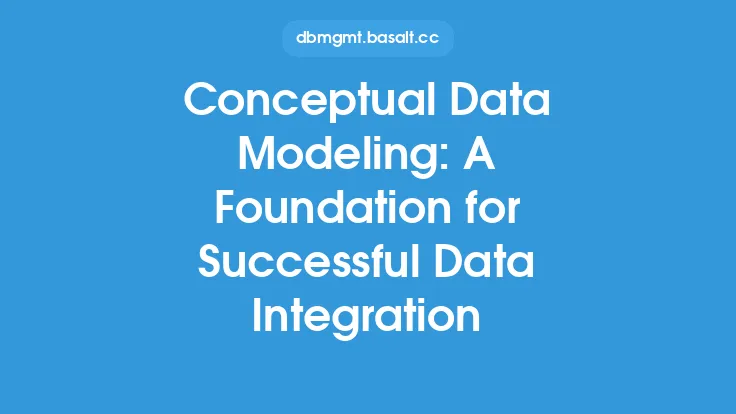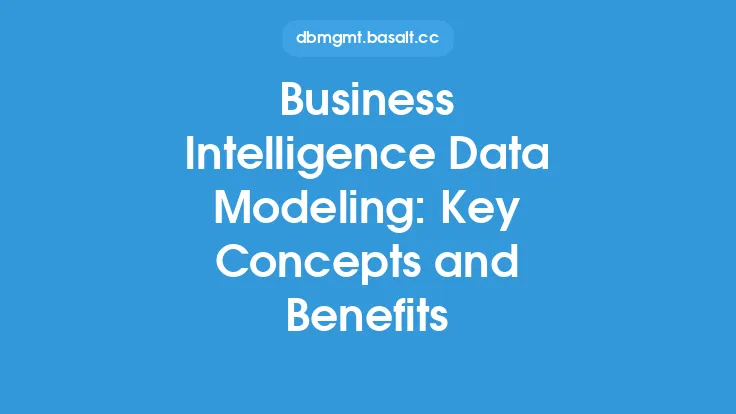Data modeling is a crucial aspect of business intelligence, as it provides a foundation for organizing, managing, and analyzing data to support informed decision-making. At its core, data modeling involves creating a conceptual representation of an organization's data assets, which can be used to design and implement databases, data warehouses, and other data storage systems. In the context of business intelligence, data modeling plays a critical role in ensuring that data is properly structured, integrated, and accessible to support analytics, reporting, and other business intelligence applications.
Introduction to Data Modeling Concepts
Data modeling involves several key concepts, including entities, attributes, and relationships. Entities are objects or concepts that have significance to the organization, such as customers, products, or orders. Attributes are the characteristics or properties of these entities, such as customer name, product description, or order date. Relationships, on the other hand, describe how entities interact with each other, such as a customer placing an order or a product being part of an order. By defining these concepts, data models provide a framework for understanding the structure and meaning of an organization's data.
Data Modeling Techniques
There are several data modeling techniques that can be used to create a data model, including entity-relationship modeling, dimensional modeling, and object-oriented modeling. Entity-relationship modeling is a traditional approach that focuses on defining entities, attributes, and relationships. Dimensional modeling, on the other hand, is a technique that is specifically designed for data warehousing and business intelligence applications. It involves organizing data into facts and dimensions, where facts are measures or metrics, and dimensions are categories or attributes that provide context for the facts. Object-oriented modeling is a more modern approach that uses object-oriented programming concepts, such as classes and objects, to model data.
Data Modeling for Business Intelligence
In the context of business intelligence, data modeling is critical for ensuring that data is properly structured and integrated to support analytics and reporting. A well-designed data model can help to identify data gaps, inconsistencies, and redundancies, and provide a framework for integrating data from multiple sources. It can also help to ensure that data is properly normalized, which is essential for supporting complex queries and analytics. Additionally, a data model can provide a common language and framework for communicating with stakeholders, including business users, IT professionals, and data analysts.
Data Warehousing and Business Intelligence
Data warehousing is a critical component of business intelligence, as it provides a centralized repository for storing and managing data. A data warehouse is a database that is specifically designed for querying and analyzing data, rather than supporting transactional systems. It is typically optimized for querying and reporting, and is often used to support business intelligence applications, such as dashboards, scorecards, and data mining. Data modeling plays a critical role in data warehousing, as it provides a framework for designing and implementing the data warehouse. This includes defining the data structures, relationships, and hierarchies that are used to store and manage data.
Data Governance and Data Quality
Data governance and data quality are essential components of data modeling for business intelligence. Data governance refers to the policies, procedures, and standards that are used to manage and ensure the quality of an organization's data assets. This includes defining data ownership, data stewardship, and data quality metrics, as well as establishing processes for data validation, data cleansing, and data normalization. Data quality, on the other hand, refers to the accuracy, completeness, and consistency of an organization's data assets. It is critical for ensuring that data is reliable and trustworthy, and that it can be used to support informed decision-making.
Data Modeling Tools and Technologies
There are several data modeling tools and technologies that can be used to support data modeling for business intelligence. These include data modeling software, such as Entity-Relationship Diagram (ERD) tools, dimensional modeling tools, and object-oriented modeling tools. They also include data warehousing and business intelligence platforms, such as relational databases, column-store databases, and NoSQL databases. Additionally, there are several data governance and data quality tools that can be used to support data modeling, including data validation tools, data cleansing tools, and data normalization tools.
Best Practices for Data Modeling
There are several best practices that can be used to support data modeling for business intelligence. These include defining a clear data strategy, establishing a data governance framework, and using a standardized data modeling methodology. It is also essential to engage business stakeholders and subject matter experts in the data modeling process, and to use data modeling tools and technologies that are scalable, flexible, and easy to use. Additionally, it is critical to ensure that data models are properly documented, maintained, and updated, and that they are aligned with the organization's overall business strategy and objectives.
Conclusion
In conclusion, data modeling is a critical component of business intelligence, as it provides a foundation for organizing, managing, and analyzing data to support informed decision-making. By using data modeling techniques, such as entity-relationship modeling, dimensional modeling, and object-oriented modeling, organizations can create a conceptual representation of their data assets that can be used to design and implement databases, data warehouses, and other data storage systems. By following best practices, such as defining a clear data strategy, establishing a data governance framework, and using standardized data modeling methodologies, organizations can ensure that their data models are scalable, flexible, and aligned with their overall business strategy and objectives.





